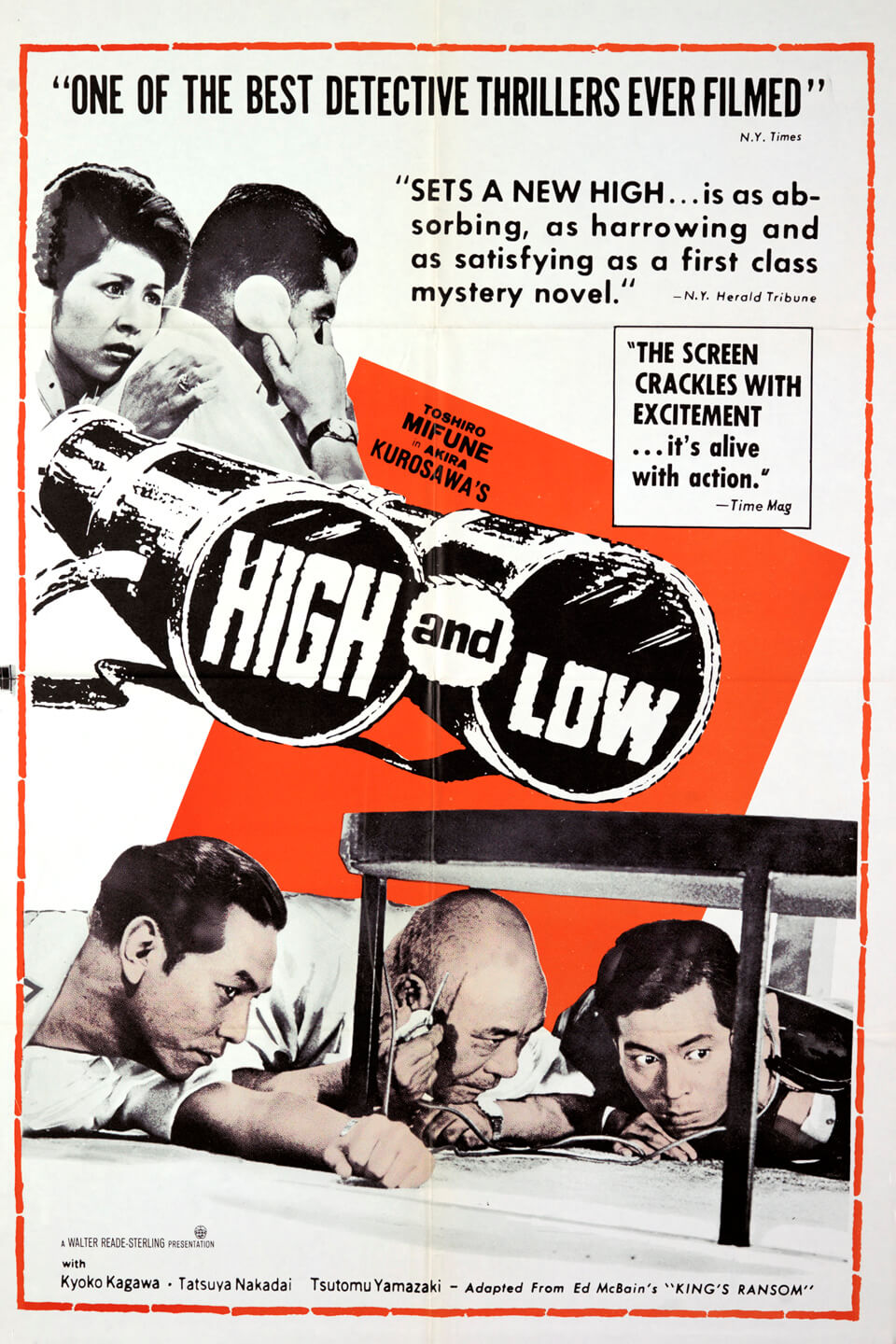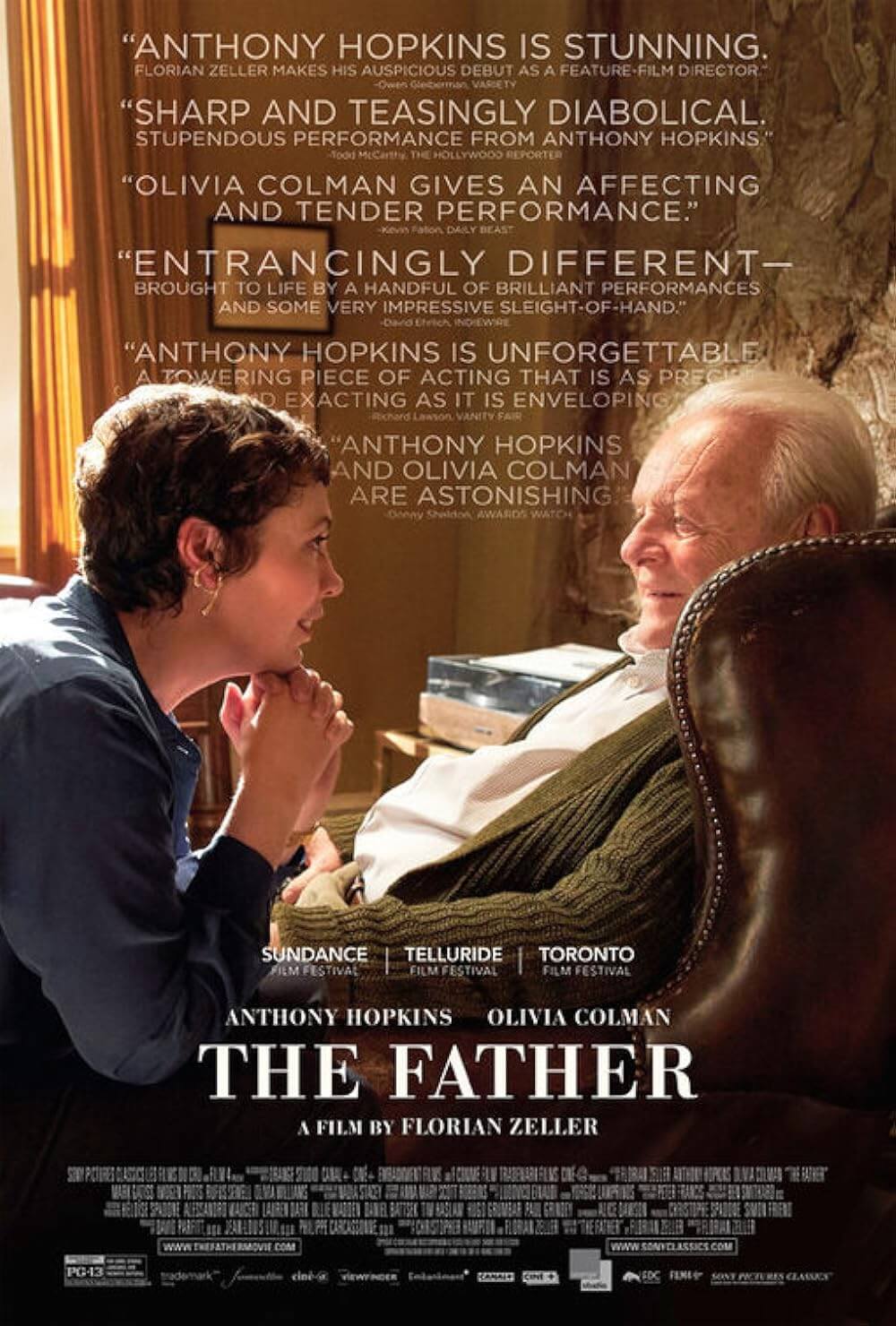The Definitives
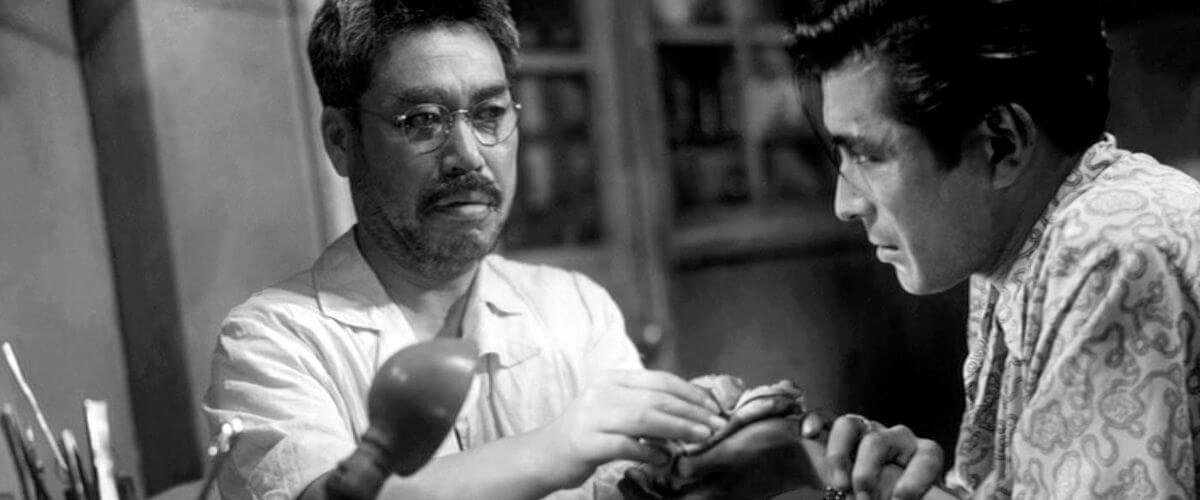
Drunken Angel
Essay by Brian Eggert |
Rather than a picturesque park or square, a festering cesspool resides at the hub of the neighborhood in Drunken Angel, the 1948 release and first major cinematic accomplishment by Japanese master Akira Kurosawa. The bubbling sump, perhaps gutted during United States bombings of Japan in WWII, fills the craterous earth with disease, refuse, and bile water, along with leftover wartime debris such as burnt wood and a small shoe. The bombed-out crater is the spleen of Kurosawa’s postwar society. The pond reflects characters grim enough to stare into it, signaling Japan’s universal postwar despair, called the kyodatsu condition. The defeat of the Imperial Army marked a staggering blow to Japan’s sense of honor, and with the U.S. army’s Occupation of Japan, the country’s citizens were reminded of their embarrassment every time Western influence reared its invasive head. Through the course of Drunken Angel, the director looks at the culture of postwar Japan under the Occupation, and he finds Japanese culture divided between the occupational forces and the yakuza gangs that emerged from the postwar climate. To be sure, the cesspool becomes a symbol for the poison that war leaves on a culture in its wake, preventing the personal growth required to achieve a well-formed cultural identity.
For Kurosawa, the only thing worse than disgrace and humiliation was to profit from it. Yakuza gangs thrived in this postwar atmosphere, exploiting national desperation by maintaining the infinitely profitable Black Market. With Japan lamenting their defeat and criminality prospering, Kurosawa sought to bring down the gangs. In his book Something Like an Autobiography, Kurosawa wrote, “I wanted to take a scalpel and dissect the yakuza.” In doing so, Kurosawa also places responsibility on the individual gang members: whether they were products of their own troubled existence or society’s influence did not matter; Kurosawa believed that yakuza members were individuals, thus responsible for their actions and behavior. In effect, Kurosawa makes a message film straightforwardly denouncing gangsterism, like Hollywood’s The Public Enemy had done in 1931 (though Kurosawa forgoes declaring his intentions with a soapboxing foreword, as that film does). And throughout Drunken Angel, Kurosawa’s camera returns to the cesspool to remind his audience about the conditions in postwar Japan, aiming his commentary at the culture shaped by the yakuza and, by extension, the U.S. Occupation.
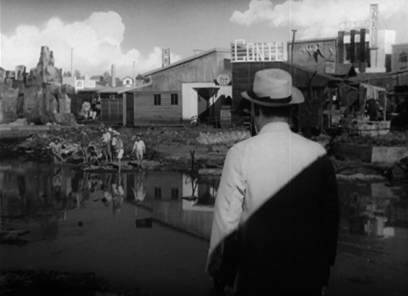 Written by Kurosawa and Keinosuke Uekusa, Drunken Angel criticizes the U.S. Occupation but keeps it mostly out of focus in the background. Albeit indirectly, the film holds Western influence responsible for generating a more organized yakuza, called gurentai. English-language signage in the market signifies the presence of a foreign entity; that entity, however subtle, infers Western influence on Japanese culture. We can imagine familiar scenes from other wartime movies with American soldiers directing traffic and harassing locals, but no such references were allowed by the occupying army. Several U.S. censorship boards were established in Japan to prevent any underlined mention of the Occupation in Japanese cinema. And yet, Kurosawa depicts his yakuza gangsters dolled up in trim suits and slicked-back hair, dancing to “Jungle Boogie” songs in their nightclub to emulate the American hoodlum culture. The Occupation sought a smooth transition and renovation of Japan, but instead, it transformed Americanized yakuza into an organization comparable to Prohibition-era mobs. In the first scenes, when yakuza boss Okada (Reisaburo Yamamoto) is released from prison, he stands by the cesspool, wearing his now-outdated kimono he had going into prison years before, during the war. The next day after his release, Okada modernizes himself into the current yakuza garb: a classy ensemble straight out of The Roaring Twenties.
Written by Kurosawa and Keinosuke Uekusa, Drunken Angel criticizes the U.S. Occupation but keeps it mostly out of focus in the background. Albeit indirectly, the film holds Western influence responsible for generating a more organized yakuza, called gurentai. English-language signage in the market signifies the presence of a foreign entity; that entity, however subtle, infers Western influence on Japanese culture. We can imagine familiar scenes from other wartime movies with American soldiers directing traffic and harassing locals, but no such references were allowed by the occupying army. Several U.S. censorship boards were established in Japan to prevent any underlined mention of the Occupation in Japanese cinema. And yet, Kurosawa depicts his yakuza gangsters dolled up in trim suits and slicked-back hair, dancing to “Jungle Boogie” songs in their nightclub to emulate the American hoodlum culture. The Occupation sought a smooth transition and renovation of Japan, but instead, it transformed Americanized yakuza into an organization comparable to Prohibition-era mobs. In the first scenes, when yakuza boss Okada (Reisaburo Yamamoto) is released from prison, he stands by the cesspool, wearing his now-outdated kimono he had going into prison years before, during the war. The next day after his release, Okada modernizes himself into the current yakuza garb: a classy ensemble straight out of The Roaring Twenties.
Takashi Shimura plays Doctor Sanada, a self-destructive alcoholic who dilutes his own rubbing alcohol to further his addiction. In one scene, Sanada chases an alcoholic patient out of a bar from professional concern but then he sits himself down for a drink. Sanada hates disease and fights it with an unparalleled passion; disease represents something he can defeat without personal involvement, as opposed to the unrealistic effort of self-healing. To be sure, it is his choice to be a wreck. Sanada places himself in the slum, shooing children away from the decrepit cesspool, while his former classmates work in the best hospitals in Tokyo. Stumbling into Sanada’s clinic, Matsunaga (Toshiro Mifune) wants a bullet removed from his hand. Sanada agrees but makes the hood pay for his crimes, denying him anesthesia and charging him extra. While stitching his patient’s wound, Sanada notices that Matsunaga has a cough and fever, which are signs of a hole in his lung, and suggests Matsunaga may have Tuberculosis. Advising him to get X-rays, Sanada warns that even if treated, Matsunaga will likely die of the affliction. Even after getting X-rays to confirm the TB, Matsunaga does not view the results, afraid of what they might mean. Instead, he continues with his wild gangster lifestyle, filled with smoking, drinking, and late nights. He commits virtual suicide in the process. Like Sanada, he too denies the reality of his existence.
Through Matsunaga, Kurosawa highlights the self-destructive nature of yakuza gangs against their country. And while other doctors might chalk up Matsunaga’s rejection of treatment to an ignorance is bliss worldview, Sanada takes it personal, as if his salvation depends on Matsunaga’s health. Sanada and Matsunaga’s doctor-patient relationship becomes a brotherhood, wherein a revolving sense of purpose is bestowed between them. Matsunaga pushes the Doctor away, thus providing a way for Sanada to save himself through the (attempted) healing of others. In his conversations with his patient, Sanada stresses the importance of life, thus calling for Matsunaga’s introspective examination. Several mentions of Sanada’s youth suggest he was once just like Matsunaga, young and proud, even defending his arrogant buoyancy comparable to the jealously preserved yakuza honor. Meanwhile, Matsunaga plays the part of a gangster well, dressing himself like a doll. He desires to escape from his lifestyle, to survive in spite of his self-destructiveness, and he repeatedly visits Sanada, lingering around his drunken angel in hopes that he might be rescued.
During this time, Okada has set his sights on his former lover (Chieko Nakakita), who now serves as Sanada’s nurse, thus threatening Matsunaga’s new friend. But a dream compels Matsunaga to intervene. The dream sequence finds Matsunaga running on a beach in yakuza garb, chased by a non-gangster version of himself. Matsunaga’s self-reflection, in the face of his encroaching death from TB, allows him to awake from complacency. All at once the hateful death drive lifestyle of the yakuza becomes his enemy. At that moment, Okada becomes the personification of Matsunaga’s failure and wasted life; therefore, Matsunaga must face his enemy to remove his costume altogether. He confronts Okada in a bloody knife fight. The two struggle down a hallway, knocking over cans of white paint, leaving both men covered in white paint. As their blood splatters on the pools of paint on the floor, the scene looks like a Jackson Pollack painted in violence. But Matsunaga’s attempt at redemption fails; Okada stabs him in the back, killing him.
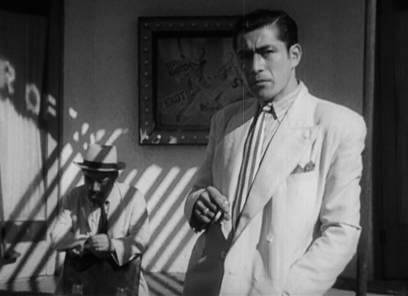
Drunken Angel has been described as a film noir, an apt comparison given Matsunaga’s dramatic arch. In archetypal noir style, Matsunaga tries to escape a life of crime only to be punished for his past misdeeds, not unlike the doomed protagonists in Double Indemnity (1944) and Out of the Past (1947). However, Kurosawa is less concerned with a noirish tragedy than lamenting the social conditions of gangsterism and the Occupation. In the final scene, Sanada does not realize Matsunaga sought redemption in his attack on Okada. After all, Sanada could not have known what Matsunaga dreamt nor understood that he attacked Okada to redeem himself. Instead, Sanada blames Matsunaga for what happened and believes he succumbed to his gangster lifestyle, that it consumed him. In a way, Sanada is correct, as Matsunaga’s bid for vengeance was certainly the act of a criminal, whereas Sanada would have preferred that Matsunaga simply walked away from the conflict. In this sense, Drunken Angel adopts a film noir structure and, at the same time, censures the idea of gangsterism from a purely humanist perspective.
Kurosawa refused to allow the gangster to become the film’s hero; and so, Matsunaga does not emerge victoriously and existentially purified from the final confrontation. Though other historians have argued that Matsunaga sheds his gangster costume and, in that act, ceases to be a gangster, he still propels himself into a final act of gangster violence. Matsunaga may have found some clarity in the last moments of his life, but Kurosawa refuses to grant him absolution. Despite the fatalistic conclusion for Matsunaga, Kurosawa offers an inkling of optimism by giving Sanada the happiest ending possible for a film like Drunken Angel. A young girl and patient (Yoshiko Kuga) who, like Matsunaga, suffers from TB, appears early in the film. Sanada tells her that “will power” can cure her disease. In the film’s final scene, the doctor looks over the cesspool, mournful and angry about Matsunaga’s death. The sickly girl joins him; she has recovered from her ailment. Sanada realizes that his earlier advice to the girl was indeed accurate. Though Matsunaga’s will power came too late and relied on violence to heal his affliction of gangsterism, those with the fortitude can heal themselves. This is Kurosawa’s message to Japan in the wake of their kyodatsu condition.
Kurosawa’s camera returns to the cesspool throughout the film, as if asking Why does this sump remain? The implication is that yakuza gangsterism sends Japan into the lower depths; and while the occupational forces should be a restructuring presence, they do nothing to prevent it. Japan is caught in the middle to suffer as both institutions, Western influence and yakuza gangs, drain the essence from Japanese dignity. The sump continues to bubble with symptoms of kyodatsu, while ingrained American occupants act as an ever-present and disgraceful reminder, and the yakuza benefit from the national spiritual miscarriage. Through these themes, Kurosawa finds his longstanding harmony between story and social relevancy, whereas before he mastered only one or the other. Made just before his seminal work Rashomon (1950), Kurosawa considered Drunken Angel to be his first whole film. He wrote in his autobiography, “It was my picture. I was doing it and no one else.” Before this, he made six other pictures, each with their moments and thematic allusions to his later films, but in no way were they as complete a narrative, nor as dramatically powerful.
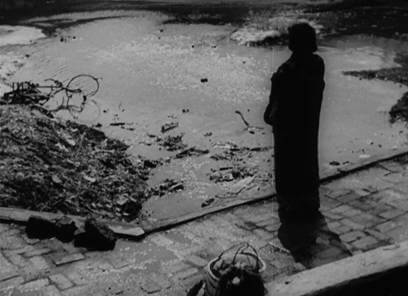
Drunken Angel marks the first collaboration between its director and unrivaled actor Toshiro Mifune; but perhaps more importantly, the film was the first of several Kurosawa pictures where elder acting legend Takashi Shimura would play spiritual guide to Mifune’s apprentice. Kurosawa films like Stray Dog (1949), The Quiet Duel (1949), and Seven Samurai (1954) were to follow, all wherein Shimura teaches Mifune’s naïve character life lessons, usually acting as a parental supporting role to Mifune’s lead. Shimura sensei roles over Mifune each find the actor bemused with the impetuous energy of the younger character. Drunken Angel begins this dynamic with a calloused surface, unlike many of the collaborations to follow. Kurosawa and Uekusa came upon their Sanada while scouting the Black Market underground for inspiration. They found an alcoholic doctor in a slum, talking about his treatment of gynecological diseases with a perverse lack of discretion. The doctor looked worn, with several days’ growth of facial hair, tired eyes, and a lively tone in his discussion. Shimura brings the character to life, complete with blunt diagnoses, ruthless bedside manner, yet an endearing dedication worthy of a savior.
Though the Kurosawa-Mifune relationship produced the most popular films in either of their careers, the Kurosawa-Shimura partnership lasted longer and supplied fixed stability, enduring from Kurosawa’s first film Sanshiro Sugata (1943) to one of his last, Kagemusha (1980). Shimura’s appeal is punctuated by delicacy and empathy, while Mifune was a more kinetic force, one Kurosawa allowed to surge freely, eventually creating a timeless icon of international cinema. Shimura never achieved such international celebrity; his popularity nested exclusively in Japan as the second most popular Japanese actor. Mifune could play sentimental, just as Shimura could, but his onscreen intensity defined him. When Drunken Angel opened in theaters, Mifune’s brand of wild energy was yet unknown to prevalent Japanese acting styles. His performance overpowers Shimura—who otherwise represented the thematic core of the film—stealing the movie and solidifying a name for himself as a true original. (Worth noting is the 1965 Kurosawa-Mifune picture Red Beard, the last collaboration between the director and actor in a partnership that lasted through fifteen pictures over seventeen years. Mifune plays a version of Shimura’s Sanada—a stubborn-but-lovable doctor—in a film that, in Japan, would become their most popular and successful film together.)
Drunken Angel’s narrative structure is mirrored in Kurosawa’s Ikiru, the 1952 drama in which Shimura’s civil servant character Watanabe awakes from a similar complacency after discovering he has stomach cancer. In his last weeks of life, Watanabe manipulates a bureaucratic system to do one worthy deed in his otherwise pointless life: clean up a foul landfill and turn it into a children’s playground. Both Matsunaga and Watanabe fight their own system of oppression; Matsunaga fights the representation of himself and yakuza gangsterism: Okada. Drunken Angel views its culture from a fatalistic stance, as evidenced by the cesspool that remains throughout the film. As a contrast to the vile gangster types in the film, Kurosawa puts forth the alcoholic Sanada, an altruistic and wounded hero willing to help a troubled gangster see the error of his ways. “Angel” though he may be, Sanada cannot save Matsunaga, nor will the film’s story resolve the cultural woes depicted. Kurosawa scholar Donald Richie remarked on the director’s recurring theme: “no single person is as good as the world is bad.” Such a theme may seem defeatist, but it reveals the death of Japan’s prewar cultural identity, now replaced with a culture steeped in the kyodatsu condition, riddled by yakuza gangs, and influenced by occupational forces. This artful, ultimately sobering film finds Kurosawa showing his audience a grim picture of their culture mirrored in all the rottenness of the enduring cesspool.
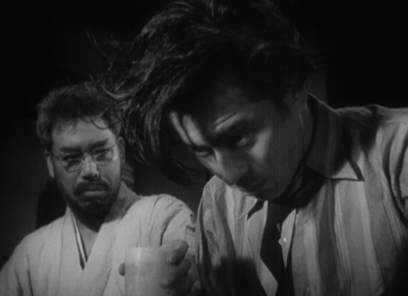
As suggested, occupational oversight prevented any anti-democratic or anti-U.S. sentiments getting through the largely Western censor boards in the time Kurosawa was shooting Drunken Angel. Films deemed unsuitable were either never made or pulled from theaters. Aware of this, Kurosawa’s depiction of the American presence in Japan recedes into the backdrop to avoid any overt, censorable association between the yakuza and their American influencers. Nonetheless, nightclub scenes cannot help but depict the yakuza as emulating Western behavior. Through such minor flourishes, Kurosawa diagnoses Japan with the disease of Americanization, even while directing under the U.S. military’s Occupation of Japan. Nonetheless, Kurosawa’s film underwent a number of changes, including a dramatically altered last scene, as military and industry censors demanded preapproval of all Japanese scripts. Any sense of Nationalism or mention of the Occupation were strictly cut. But, always cleverly subversive, the director still implies the repercussions of the Occupation on Japanese culture.
Kurosawa believed the Japanese people lost their cultural identity during the Occupation, largely because the occupational forces both enabled democracy and repressed many Japanese traits in order to maintain control. The director sought to denounce such behavior with Drunken Angel and deride the yakuza for their petty conduct as a community rooted in pimps, violence, drugs, and corruption. Drunken Angel is by no means Akira Kurosawa’s greatest achievement; rather, it is his first vital narrative and his first whole thesis on Japan’s postwar kyodatsu condition of many to follow. The director’s preoccupation with Japan’s postwar despair first appears in his 1946 film No Regrets for Our Youth, and it lasts all the way into 1991 with Rhapsody in August, his cinematic response to the Hiroshima and Nagasaki atomic bombs. Kurosawa’s commentary is not invasive; it lingers just behind his narrative, allowing the poetic relationship of his characters to involve us as his underlying message swells the material to his artistic designs.
(Editor’s Note: The above article was expanded from the original version, first published in 2007.)
Bibliography:
Dower, John W. Embracing Defeat: Japan in the Wake of World War II. New York: Norton & Company, 1999.
Galbraith IV, Stuart. The Emperor and the Wolf: The Lives and Films of Akira Kurosawa and Toshiro Mifune. New York: Faber and Faber, 2002.
Goodwin, James. Akira Kurosawa and Intertextual Cinema. Baltimore: Johns Hopkins University Press, c1994.
Kurosawa, Akira. Something Like An Autobiography. New York : Knopf: distributed by Random House, 1982.
Richie, Donald. The Films of Akira Kurosawa, Third Edition, Expanded and Updated. With additional material by Joan Mellen. Berkeley, Calif.: University of California Press, 1996.
Richie, Donald; Schrader, Paul. A Hundred Years of Japanese Film: A Concise History, with a Selective Guide to DVDs and Videos. Tokyo; New York: Kodansha International: Distributed in the U.S. by Kodansha America, 2005.
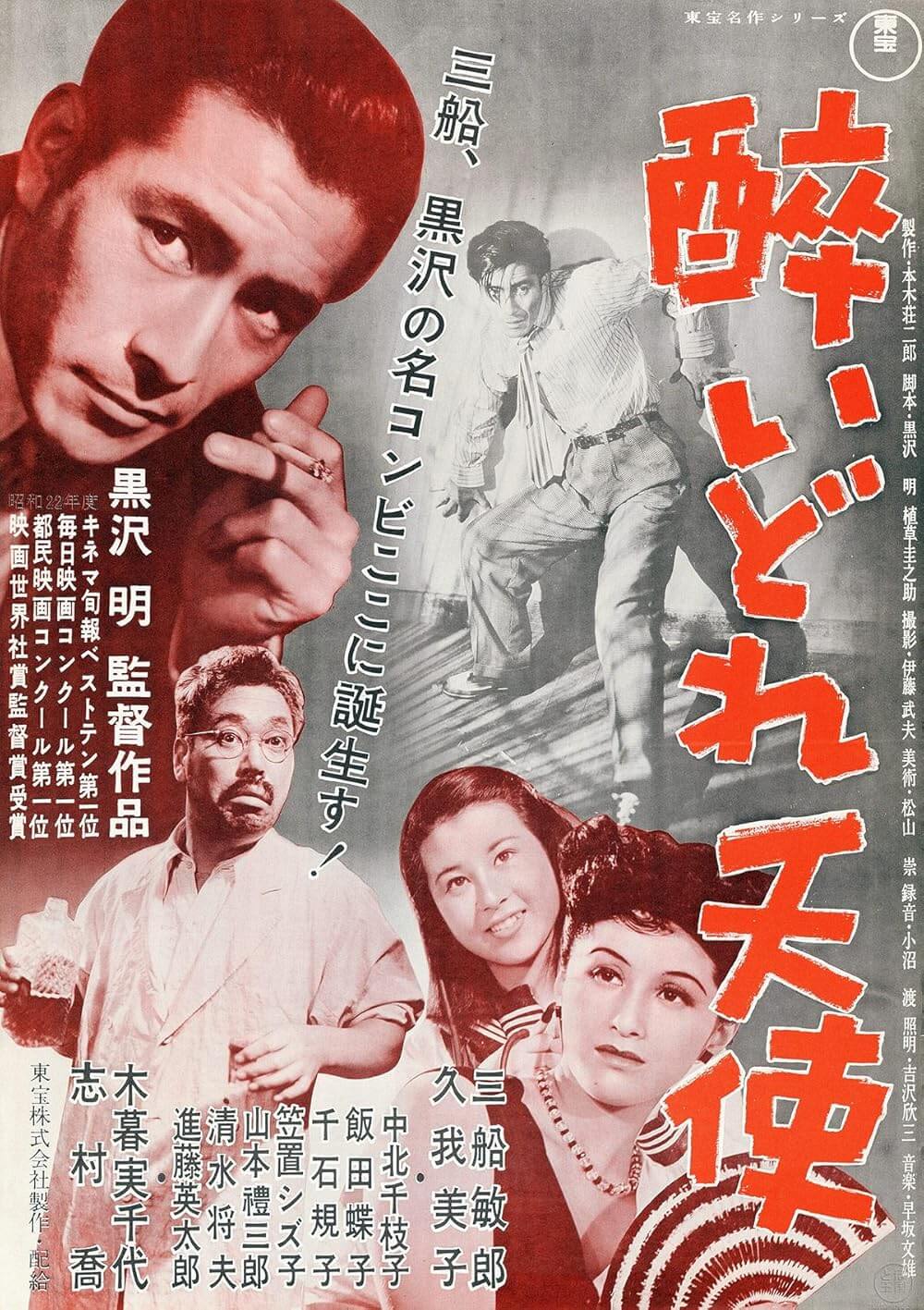
Unlock More from Deep Focus Review
To keep Deep Focus Review independent, I rely on the generous support of readers like you. By joining our Patreon community or making a one-time donation, you’ll help cover site maintenance and research materials so I can focus on creating more movie reviews and critical analysis. Patrons receive early access to reviews and essays, plus a closer connection to a community of fellow film lovers. If you value my work, please consider supporting DFR on Patreon or show your support in other ways.
Thank you for your readership!
Brian Eggert | Critic, Founder
Deep Focus Review


